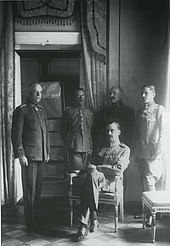Adjutant
![]()
This article or subsequent section is not sufficiently supported by evidence (e.g., anecdotal evidence). Information without sufficient evidence may be removed in the near future. Please help Wikipedia by researching the information and adding good supporting evidence.
![]()
This article is about the officer attached to the troop commander for support; for the auxiliary minelayer of the same name, see Adjutant (ship, 1937); for the tugboat and tender, see Adjutant (ship, 1905).
The adjutant is an officer attached to the commander of the troops for support. The word adjutant comes from the Latin adiuvare 'to help, support' and means as much as assistant. It refers first to a military position, but also to a rank.
The term was first used in France for the major's aides, major not being a rank but the service designation for the officer who was responsible for the organization (personnel, rations, ammunition) in the unit. From here the word also entered the German military language.

The Finnish Reichsverweser Gustaf Mannerheim (seated) with his adjutants, (from left) Lieutenant Colonel Lilius, Captain Kekoni, Lieutenant Gallen-Kallela, Ensign Rosenbröijer.
Germany
The adjutants had the task of supporting the commander in his leadership duties, training and military business. Often they divided the services, kept diaries and message books and had to receive and deliver messages and orders. In the German Reich, adjutants were mounted on duty due to their function, later motorized.
Higher adjutants were the adjutants at the higher command posts, i.e. from brigades upwards. The duties of an adjutant in a brigade, division, army corps, army or army group were personnel work, i.e. replenishment, awards, promotions and officer appointments. Thus, the scope of duties roughly corresponded to that of a G1 (A1) officer in staffs in NATO and the Bundeswehr. The external insignia of the adjutants in the German Army was an adjutant's sash or adjutant's catch cord worn over the right shoulder.
Personal aides typically had only the princes of ruling houses. The adjutants of ruling princes were called wing adjutants (with the rank of staff officers). Superior to them were the (First) Adjutants General (in Prussia since 1758), the monarchs' adjutants of general rank.
In the Bundeswehr, adjutants are regularly assigned to a general from the position of division commander. As a rule, a division commander is assigned a captain (grade A11). The higher the rank of the commander to be supported, the higher the rank of the adjutant assigned to him. Finally, an adjutant of the rank of colonel (or captain at sea) is assigned to the Federal President.
France
In France, the rank of adjudant was introduced into the army in 1776; it designated the senior non-commissioned officer of a battalion, later also of a company. Today, the adjudant is preceded by the adjudant-chief and the major.
During the Revolutionary Wars, an "Adjudant-général" existed as the head of administration on the staff of a division. It was not a rank, but an official position. The Adjudant-général replaced the Maréchal de camp in the function as "Chef d'état-major des armées" (roughly: Chief of the Army Staff). This was an officer up to the rank of Commandant. He was usually addressed in the short form "Général". In 1800, the service title was changed to "Adjudant-commandant". After the end of the Empire, this designation was again abolished. One of the best known of the "Adjudant-général" / "Adjudant-commandant" was the later Maréchal Michel Ney.
As a badge of office they wore a star on the epaulette.
In the current French Army, the rank of "Adjudant" is equivalent to Staff Sergeant.
See also: Ranks of the French Armed Forces
Search within the encyclopedia